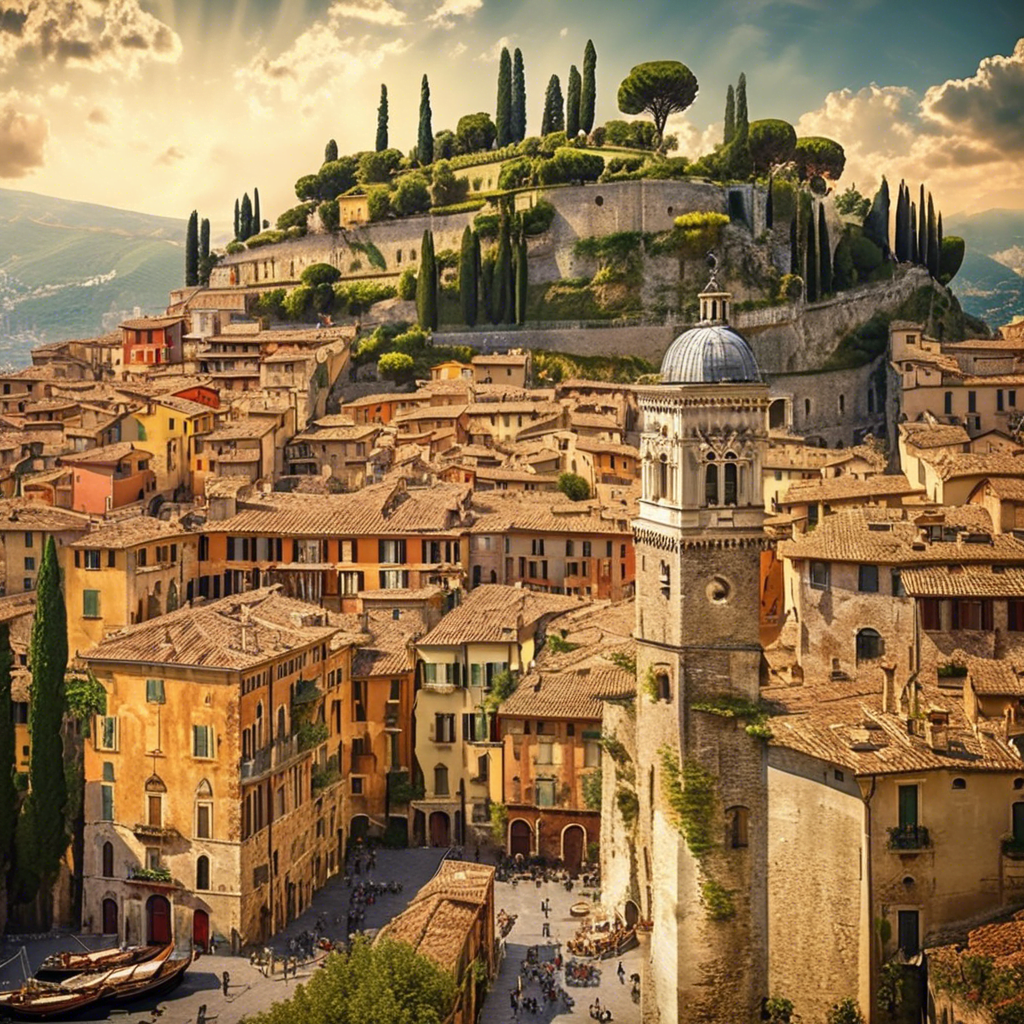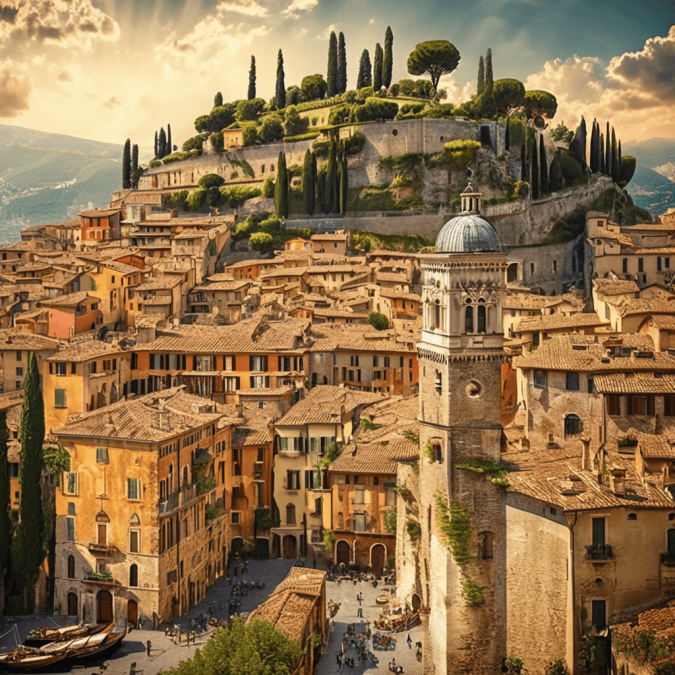
1. Introduction
Italy rich and diverse history has played a pivotal role in shaping its cultural, political, and social landscape. This project aims to provide a comprehensive exploration of Italy’s historical journey from ancient times to the present, highlighting key periods and themes that have defined the nation’s identity. By delving into the intricate tapestry of Italy’s past, we seek to unravel the complexities of its evolution and shed light on the forces that have shaped the country we know today.
2. Pre-Roman Italy (Before 753 BC)
Overview of the ancient civilizations that inhabited the Italian peninsula, including the Etruscans, Greeks, and Italic tribes
Italy’s pre-Roman era was marked by the presence of diverse civilizations, each contributing to the cultural tapestry of the region. The Etruscans, known for their advanced art and architecture, inhabited central Italy, while Greek colonies dotted the southern regions, bringing with them a rich cultural heritage. The Italic tribes, such as the Latins and Sabines, established early city-states that laid the foundation for the future development of Italy.
Development of early city-states such as Rome, Alba Longa, and Veii
The emergence of city-states in pre-Roman Italy marked the beginning of urbanization and political organization in the region. Rome, founded in the 8th century BC, rose to prominence as a powerful city-state that would eventually dominate the Italian peninsula and beyond. Alba Longa and Veii were other significant city-states that played key roles in shaping the political landscape of ancient Italy.
Influence of Greek colonization on southern Italy and Sicily
Greek colonization of southern Italy and Sicily brought Hellenic culture, art, and architecture to the region, creating vibrant centers of trade and cultural exchange. Cities like Syracuse and Tarentum became important hubs of Greek influence, blending Greek traditions with indigenous Italic customs. The legacy of Greek colonization in Italy can be seen in the art, literature, and philosophy that flourished in the region.
3. Roman Republic and Empire (753 BC – 476 AD)
Establishment of the Roman Republic and its expansion across the Mediterranean
The founding of the Roman Republic in 509 BC marked the beginning of Rome’s ascent to power and influence in the ancient world. Through a series of military conquests, alliances, and diplomatic maneuvers, Rome expanded its territory across the Mediterranean, establishing a vast empire that would shape the course of Western civilization.
Key events and figures in Roman history, such as the Punic Wars, Julius Caesar, and Augustus
The Punic Wars against Carthage, the rise of Julius Caesar as a military and political leader, and the reign of Emperor Augustus are key milestones in Roman history. The conflicts with Carthage solidified Rome’s control over the western Mediterranean, while Caesar’s assassination and the subsequent rise of Augustus as the first Roman Emperor marked a transition from the Republic to the Empire.
Decline and fall of the Western Roman Empire, including invasions by barbarian tribes
The decline of the Western Roman Empire in the 5th century AD was precipitated by internal strife, economic challenges, and invasions by barbarian tribes such as the Visigoths, Vandals, and Ostrogoths. The sack of Rome in 410 AD by the Visigoths and the deposition of the last Roman emperor in 476 AD symbolized the end of an era and the beginning of a new chapter in Italy’s history.
4. Early Medieval Italy (476 AD – 1000 AD)
Fragmentation of Italy after the fall of the Roman Empire
Following the collapse of the Western Roman Empire, Italy descended into a period of political fragmentation and instability. Various Germanic tribes established kingdoms in different regions of Italy, leading to a decentralized political landscape characterized by shifting alliances and conflicts.
Byzantine rule in southern Italy and the rise of the Lombards in the north
The Byzantine Empire exerted control over southern Italy, establishing the Exarchate of Ravenna as a stronghold of Byzantine authority. Meanwhile, the Lombards, a Germanic tribe, established the Kingdom of the Lombards in northern Italy, creating a distinct political entity that would shape the future of the region.
Charlemagne’s conquest of Italy and the establishment of the Holy Roman Empire
Charlemagne, King of the Franks, launched a series of military campaigns to conquer Italy and establish his authority over the region. In 800 AD, Charlemagne was crowned Emperor of the Romans by Pope Leo III, laying the foundation for the Holy Roman Empire and shaping the political landscape of medieval Italy.
5. High Middle Ages (1000 AD – 1300 AD)
Growth of city-states like Venice, Genoa, and Florence
The High Middle Ages witnessed the rise of powerful city-states in Italy, including Venice, Genoa, and Florence. These maritime republics became centers of trade, commerce, and cultural exchange, fostering economic prosperity and artistic innovation.
Rise of the maritime republics and their economic and cultural achievements
The maritime republics of Venice, Genoa, and P Florence played a crucial role in shaping Italy’s cultural landscape during the High Middle Ages. These city-states developed sophisticated trading networks, established colonies in the Mediterranean, and engaged in diplomatic relations with other European powers, contributing to the economic growth and cultural flourishing of the region.
Conflict between the Papacy and the Holy Roman Empire, including the Investiture Controversy
The High Middle Ages were also marked by ongoing power struggles between the Papacy and the Holy Roman Empire. The Investiture Controversy, a conflict over the appointment of bishops and the authority of secular rulers in ecclesiastical matters, pitted the Papacy against the Emperor, leading to a prolonged struggle for supremacy that shaped the political dynamics of medieval Italy.
6. Renaissance (14th – 17th centuries)
Cultural and artistic flourishing in Italy, with emphasis on humanism and classical revival
The Renaissance, a period of cultural rebirth and intellectual revival, transformed Italy into a vibrant center of artistic and intellectual innovation. Humanism, a philosophical and cultural movement that emphasized the study of classical texts and the potential of human achievement, fueled a resurgence of interest in literature, art, and science.
Key figures of the Renaissance, including Leonardo da Vinci, Michelangelo, and Galileo Galilei
The Renaissance produced a constellation of brilliant minds whose contributions to art, science, and philosophy shaped the course of Western civilization. Leonardo da Vinci’s artistic genius, Michelangelo’s sculptural mastery, and Galileo Galilei’s groundbreaking discoveries in astronomy and physics exemplified the spirit of innovation and creativity that defined the Renaissance era.
Political developments in Italy, including the Italian Wars and the establishment of princely states
The Renaissance was also a period of political upheaval and conflict in Italy, as powerful city-states and princely dynasties vied for control and dominance. The Italian Wars, a series of conflicts fought between rival states and foreign powers, reshaped the political map of Italy and laid the groundwork for the emergence of princely states that would dominate the peninsula in the centuries to come.
7. Italian Unification and the Risorgimento (19th century)
Overview of the Risorgimento movement and its goal to unify Italy
The Risorgimento, or “Resurgence,” was a political and social movement that sought to unify Italy and establish a modern nation-state. Inspired by nationalist ideals and a desire for independence from foreign rule, the leaders of the Risorgimento mobilized popular support for the cause of Italian unification.
Key figures such as Giuseppe Garibaldi, Count Cavour, and King Victor Emmanuel II
Giuseppe Garibaldi, a charismatic military leader, Count Camillo di Cavour, a shrewd statesman, and King Victor Emmanuel II of Piedmont-Sardinia were central figures in the Risorgimento movement. Their strategic alliances, military campaigns, and diplomatic negotiations played a crucial role in achieving the dream of Italian unification.
Unification of Italy in 1861 and the challenges of creating a unified nation
The culmination of the Risorgimento came with the unification of Italy in 1861, when the various states and territories of the Italian peninsula were brought together under a single government. However, the process of nation-building was fraught with challenges, including regional rivalries, cultural differences, and socio-economic disparities that would shape Italy’s political landscape for years to come.
8. Modern Italy (20th century to present)
Italy’s role in World War I and the rise of Fascism under Benito Mussolini
Italy’s involvement in World War I and the economic and social upheaval that followed laid the groundwork for the rise of Fascism under Benito Mussolini. Mussolini’s authoritarian rule, characterized by nationalist fervor and militaristic expansionism, transformed Italy into a totalitarian state and aligned it with Nazi Germany during World War II.
Italian participation in World War II and the aftermath of the conflict
Italy’s participation in World War II as a member of the Axis powers had devastating consequences for the country, leading to widespread destruction, loss of life, and economic collapse. The aftermath of the war saw Italy divided between the Allied-occupied north and the fascist-controlled south, setting the stage for a period of political turmoil and reconstruction.
Economic boom of the 1950s and 1960s, followed by political turmoil and social changes in the late 20th century
The post-war period witnessed an economic boom in Italy, fueled by industrialization, urbanization, and technological innovation. The 1950s and 1960s were a time of unprecedented prosperity and social change, as Italy emerged as a leading industrial power in Europe. However, the late 20th century saw political instability, corruption scandals, and social unrest that challenged Italy’s democratic institutions and tested its resilience as a modern nation.
9. Conclusion
Italy’s history is a testament to the enduring legacy of its past and the resilience of its people in the face of adversity. From the ancient civilizations of pre-Roman Italy to the cultural renaissance of the High Middle Ages, the struggle for unification in the 19th century, and the challenges of the modern era, Italy’s history is a tapestry of triumphs and tribulations that have shaped its identity and its place in the world. By exploring the complexities of Italy’s past, we gain insight into the forces that have shaped its present and lay the foundation for a deeper understanding of its future.
